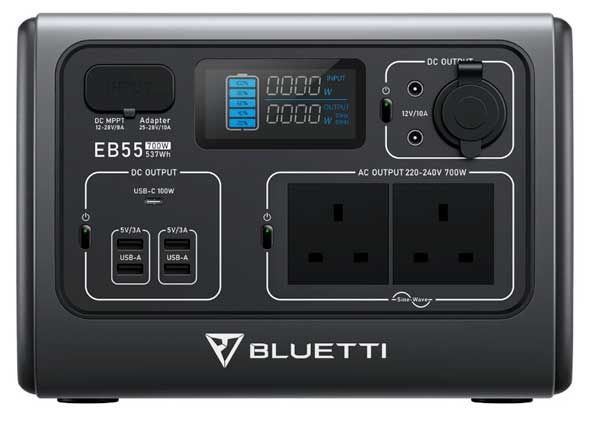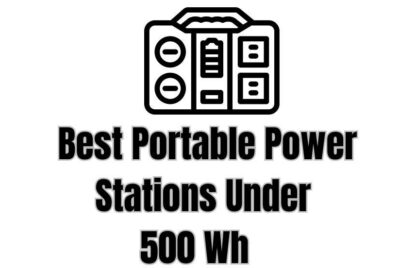The Best Portable Power Stations Under $500: Top Affordable Picks for 2024
I may earn a commission for purchases made through my links. It helps me run this site. Check out my disclosure for more details.
Portable power stations are an essential investment for campers, Rvers, and outdoor wildcats who don’t want to be constrained by short-term or a complete lack of access to the grid. They are also now extremely popular for preppers, for those who don’t want to be at the mercy of grid failures and freak weather events. Being without power can leave you stranded in the dark, and it’s not nice in extreme heat or cold.
With a reliable power station on hand, you can charge mobile devices, power small appliances, and have access to electricity during power outages or while traveling. You can even completely replace a home’s electric grid with a big enough system and the right amount of solar panels. Well, today’s topic isn’t going to cover those super-massive systems; on debate here is the type of power stations that can pull folks out of a sticky mess when the power kicks out and for people who just want some extra juice to keep their devices going when they are on the road.
So I’ll be looking at smaller systems that still pack a punch. So I’ll run through some of the best portable power stations under $500. Let’s get to it.
Top Portable Power Stations Under $500
If you’re looking for dependable portable power at your fingertips without breaking the bank, you’ve come to the right place. We’ve carefully selected a variety of models that offer exceptional value, each priced at under $500. Perfect for outdoor stays when you can’t access plug-in power, emergency backup assistance, or mobile power on the go.
If you’re looking for a light bit of power, check out our best portable power stations under $200 post. But if you want a bit more oomph without overstretching your budget, check out these machines.
EF ECOFLOW River 2

The EF ECOFLOW River 2 is a game-changer for outdoor use and regular power outages, it has the fastest charging capability of any of the portable power stations on this list and also the longest battery life cycle, at a very affordable price.
It does not have as much battery capacity as the later mentioned Jackery 500 or the FlashFish, but it’s charging and battery longevity are class leading. So what can it run, how about this:
- 60W Fridge: 3-6 hours
- 10W light: 19 hours
- Smartphone: 19 recharges
- Digital Camera: 13 recharges
- Drone: 5 charges
Not only is this a good backup companion to have around the house, it’s also good to store this 7 pound mini power station in your trunk, if you like to fly drones or work on the go and you need something with more juice and faster recharge times to keep your phone, laptops and camera gear charged up as you work and travel.
Pros
- Charges incredibly fast with its 1-hour AC X-Stream fast charging
- Can solar charge in approximately 2.3 hours with 110W solar panel
- Lightweight and highly portable for various outdoor activities
- Durable LFP battery with more than 3000 charge cycles
- 2 x AC sockets 3 X USB
Cons
- The provided 600W can be limiting for those needing to power more robust appliances
- Solar charging cable not included, requiring additional purchases for solar charging
- Could do with more USB ports.
Bluetti EB55

The Bluetti EB55 is such a phenomenal power station, in it’s own right. Let alone in the under $500 category. The bigger brother of the EB3A, it has a battery capacity of 537 watt hours. You are virtually getting a Wh of power for every dollar you spend and so much more. You can run appliances up to 700W from this power station. It’s a little heavier than some of the units on this list, weighing in at 16.5 pounds, but that would be due to the larger battery size.
Bluetti makes some wonderful portable power stations and complete solar generator kits. The EB55 continues the same forward-thinking, cutting edge tradition and has great technology, like the built-in wireless charge pad on the top and some impressive battery management features to maintain the life of your power station and stop your connected equipment from being damaged.
The EB55 also supports dual charging, so you can get a faster recharge by combining wall power and solar panels. Bluetti has given it 4 x AC outlets, 2 x DC ports and 5 x USB ports, and it can recharge a smartphone up to 50 times.
537 watt hours is a good amount of power to have at your disposal, before you get into the expense and weight of buying more expensive portable power stations. It can be charged in under 4 hours when using 1 x 200w solar panel, and if you want to charge it with your vehicle, it takes between 3 and 6 hours on average.
Pros
- 13 outlets
- wireless charge pad
- fully recharge in 1.8 hours with AC and solar combo
Cons
- heavier that some would want for mobile, on-the-move needs
- carrying handle is a bit flimsy
Jackery Explorer 300

The Jackery Explorer 300 is our top choice from Jackery in the under $500 price range for anyone who needs a compact, reliable power solution for outdoor needs or for supplementing home power. We have a full review of the Jackery 300 here.
Pros
- Almost 300 watt hours of power (293Wh)
- AC, solar, car and advanced dual input charging
- AC charging takes 4.5 hours, Solar 5-8 hours (1 x 100W SolarSaga panel), car 5.5 hours, USB-C PD + AC combo charge 2.5 hours
- Can run 6 outputs at same time : 3 x USB, 1 x DC, 2 x AC Outlet
- Lightweight -7.1 Pounds & Compact – 9.1 x 5.2 x 7.8 inches
- Add a Jackery 100w SolarSaga panel and the price will still be under $500
- Supports pass-through charging so you can charge it at the same time as you run devices off it
- Peak 500 watt surge
Cons
- Limited capacity for high-power appliances
- limited to 300 watts
The Jackery Explorer 300 is a really good companion for weekend camping trips, It’s lightweight and compact, so it’s a breeze to carry along with your gear. Charging the unit with AC power before leaving for your trip is quick enough for most people (not just as fast as the EcoFlow River 2 or Bluetti EB55 above) and highly recommended; you can get it up to 80% in about two hours using the wall outlet and USB-C port, leaving you more time to prepare for the trip instead of waiting on the battery to fill up. Alternatively, you can charge it up as you drive by plugging it into your cigarette port.
During your stay in the woods, you can keep your smartphones charged so you can blast out your favorite tunes on your Bluetooth-connected speakers and enjoy hours of music without worrying about draining the battery on your speakers and phones. The pure sine wave AC outlet will also come in handy when you need to power your small fan and LED lights as the evening rolls in. And just on that, here’s what the E300 will run on the go.
| Device | Power Consumption (W) | Approximate Run Time |
|---|---|---|
| 5W Desk Fan | 5W | 42 hours |
| 70W Mini Fridge | 70W | 3 hours |
| Smartphone | 12W | Can be charged 17 times |
| Tablet | 30W | Can be charged 7 times |
| Laptop | 60W | Can be charged 3.5 times |
Yes, I’ve thrown in the laptop stats in case you are combining work and pleasure. Despite its many benefits, the E300 has a few limitations. Yes the Explorer 300 can capably charge your smartphones and small gadgets, its 293Wh capacity isn’t designed for larger appliances like a portable heater or a high-wattage blender. So if you’re packing anything heavy-duty wattage-wise, there’s no point taking them out of the trunk. Unless you can run some grid power in, use a high-powered fuel generator, or get the loan of a high capacity portable power station.
Finally, with only two AC outlets, you might need to prioritize which devices to power if you have several that need an AC connection. Get in the queue! You can also keep the power going for a lot longer than you think if you have 1 x 100W SolarSaga panel. It will keep your power station charged as you use it, and it does the job relatively quickly. You might not get the sun you need to get in up to 100%, but you should be able to get it to 80% after 3.5 hours if you aren’t running a huge surge of appliances on it at the same time.
In conclusion, though, whether you’re heading for a weekend in the wilderness or you want to keep your devices charged during an unexpected power cut, this power station is a solid performer under $500. With a 3-year warranty, you can’t go wrong.
Jackery Explorer 500

The Jackery Explorer 500 hits the sweet spot for coming in at under $500 and providing ample power for short burst energy-demanding trips and outdoor events or work environments. The only drawback is that it only has a single AC socket. That’s why we have the Jackery 300 in a higher position on this list, it’s not as powerful but has better outlet versatility. You have 518Wh of power to play and an impressive 500W output, which can be distributed between the AC socket, DC ports and 3 X USB ports.
You can charge 6 things simultaneously with this power station, there are plenty of other options on this list that can charge more, but as you are limited by battery capacity in this price range, having more things attached will cause the battery to drain faster.
Recharge times takes 7.5 hours with an AC socket (you must use the adapter Jackery has provided a not a standard AC plug), car charging takes the same; and with 1 of Jackery’s 100W panels or your own, it takes 9.5 hours.
Pros
- 2 X DC ports, 3 X USB
- can recharge a mini cooler 9 hours
- 1000W surge
- 3 Year warranty
Cons
- Limited power outlets – only one AC socket
- short on USB connections
- short 500 battery cycle life
The Jackery is really well made and looks great in those famous colors, but it could do with quicker recharge times and a lot more outputs. What Jackery does is make well-made, dependable units with good clean power, but the E series is a bit limited compared to what their Pro series offers, and that is why Jackery doesn’t want to compete with itself by providing knockout features in the E series. Naturally, the Pro series has longer battery life, higher output, and faster charging times, but with that comes a higher price tag.
BailiBatt Power Station 300W

If you’re on the hunt for an affordable yet capable portable power station that is not one of the well-known brands, we believe the BailiBatt 300W model offers great value for its price point. It has a bigger surge than the Jackery 300, coming in at 600W, and it is also priced well below the $200 mark. This thing sells by the 1000s each month on Amazon, because it’s cheap and cheerful.
It weighs only 4.6 pounds, so it’s one of the lightest contenders on this list.
Pros
- Exceptionally lightweight, making it easy to carry around for outdoor activities
- Multiple recharging modes provide versatility in how you keep the unit powered
- 2 x AC outlets, 2 x DC ports, 4 X USB including a quick charge USB3.0
- built in flashlight
Cons
- The total output is limited to 257 watts, which may not support high-demand appliances
- Only 12 months warranty
- The LED display, although informative, can be challenging to read in bright sunlight
At just 4.6 pounds, it’s a cinch to bring along on camping trips or to take with you to outdoor work sites. Its compact size belies the punch it packs with a 69600mAh capacity, enough to keep our laptops and cameras charged throughout a busy day. But it has got that big 300W sticker on the front, but that is just for the AC power it can continuously handle and not the battery capacity.
The beauty of this little dynamo is in its dual AC outlets that emit pure sine wave electricity. This means we’ve been able to power sensitive electronics like laptops without the fear of damaging them, which is a problem with some of the more rough-and-ready units out there. Plus, the regulated 12V DC outputs provide steady power, which is critical when we need consistent performance.
That said, users who want more than 300 watts will find the BailiBatt 300W Power Station comes up a tad short. This isn’t the unit to power a full campsite or a large number of devices simultaneously, but it manages several small devices quite well. Another thing to consider is the LCD screen; in direct sunlight, it can take a bit of squinting to decipher, it’s fine in less intense light.
To conclude, the BailiBatt 300W Power Station has a good capacity for your moderate, on-the-go power needs. It’s one of the cheapest portable power stations on this list, and despite its minor limitations, it stands out as a great option for anyone who needs portable power but doesn’t want to rob the bank to purchase it.
FlashFish 600W Power Station

With a 540Wh batter capacity and the ability to output 600 watts of power, the FlashFish 600W is a serious contender in the under $500 category. For half a K, you get an extremely adequate energy distributor. It has a crazy amount of AC sockets, 6 in total, although it’s a bit overkill unless you are running lower powered appliances or devices as it will soon eat up the 540Wh battery. More doesn’t always mean better.
Pros
- 6 x AC outlets.
- 1200W Peak surge
- 2 X Wireless charge pads
- 3 x DC Ports
- 3 x USB
- Flashlight
- Features a clear LCD display for easy monitoring of power status.
Cons
- AC outlets are very close together
- Some users report the battery degrading over time.
- Solar panel for charging not included.
- Charging is a bit long
This has to win an award for the most amount of outputs in such a small and cheap power station, you can hook up to 17 appliances, which is quite simply astonishing. It also supports pass-through charging so even if you are going crazy with the connections, you can charge it up at the same time with solar, a car or some AC power.
You can charge your iPhone wirelessly, and it will also recognize compatible laptop, and charge them wirelessly as well. A lot of smart technology is being offered by a non-premium brand, so Jackery, EcoFLow, Bluetti, And Goal Zero better up their game.
To charge it back up with your car it takes 8 hours, with AC 7 hours, but with AC and USB 3 ittakes just 3.5 hours. With 1 x 400w solar panel, charging takes about 8 hours.
So what sort of run times will you get out of this:
- smart phone approx 50 charges
- digital camera 40 charges
- 35W fan 13 hours
- 60w mini cooler 8 hours
So why doesn’t this take a higher spot in the list? There has been some negative feedback as to what it can run. Some customers have reported issues with the AC sockets, not being able to power many things that fall well under the 600W limit. It seems FlashFish have a few things to sort out, instead of adding some of the latest and greatest technologies they should focus on getting the basics right, and with enough time and perhaps a bit more of an updated streamlined look they could gain some more market share
Buying Guide
When you’re narrowing down the best portable power station under $500, you’ll want to prioritise your top choices to have the best features and specs. We will guide you through the crucial aspects to ensure you make an informed purchase tailored to your energy needs.
Considerations
Capacity and Power Output:
Battery Capacity, measured in watt-hours (Wh), lets you know how much energy a power station can store, while power output, which is measured in watts (W), reflects how much energy it can provide at a time. Battery capacity will let you know how long the power station will last before it runs out. For power output, this determines whether the power station can run certain appliances.
Say for example your power station has a 300W limit, well you won’t be able to run a coffee machine if it has a 100W power rating. You also won’t be able to run multiple devices if combined, they draw more than 300W of power when they are plugged into your power station.
- Battery Capacity: Look for a power station with ample capacity to meet your intended use, which you can basically calculate by thinking of the things you want to power. You might be able to run a mini heater from your portable power station, but if it uses 300W of power and your battery capacity is 600Wh, you will only get approximately 2 hours of run time from it, so you will need to buy a larger power station or can the idea of running a mini heater through it.
- Output: Make sure the power station you are looking at has a high enough wattage to run the devices and appliances you want it to. So, in other words, calculate the combined wattage of everything you need to run. Laptops, phones, and electronic devices don’t take up a lot of power; its anything that only uses a wall plug that uses the most watts.
Ports:
Has the power station got enough ports to charge everything you want simultaneously? Has it enough quick charging USB and DC ports?
| Port Type | Ideal for |
|---|---|
| AC outlets | Laptops, small appliances |
| USB ports | Smartphones, tablets, cameras, drones |
| DC outlets | Car appliances |
| USB-C (PD) ports | Fast charging for compatible devices |
Considerations
Portability
Assess the weight and size relative to the power it offers. A lighter device might be preferable for mobility, but it shouldn’t compromise the power you require.
Battery Life Cycle
Does the power station you are considering have a long battery life cycle? Batteries are rated in life cycles. If yours is rated at 500 life cycles like the Jackery’s on this list, then after the unit goes through 500 recharges it will start to lose some of it’s capacity and will usually drop to above 80% of it’s original capacity. The EcoFlow River 2 has a phenomenal class-leading 3000 life cycle, which means that it won’t start dropping capacity until it has been discharged and recharged 3000 times, which could take 5 years or longer.
Charge Time
Focus in on how long the power station takes to recharge fully. A faster charging time means less downtime, and longer power. Thankfully, most power stations these days support pass-through charging, and a faster recharge time means less time trying to find optimum sunshine or plugging into your vehicle. With a fast recharge time, you can also effectively keep most of your devices running non-stop.
Weighing these features up will help you focus on finding a portable power station that delivers performance, capacity, and a long life, and all within a reasonable budget.




